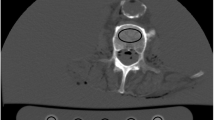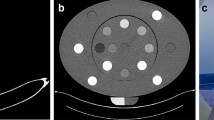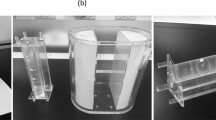Abstract
Purpose
With the advent of innovation in the preclinical studies, micro-CT provides optimized resolution by high-power X-ray output tube and flat-panel detector with ultra-short scanning time. The aim of this study was to evaluate the performance of a novel preclinical micro-CT with different parameters and protocols.
Methods
Imaging quality was evaluated by micro-CT HA and wire phantom. The high power output X-ray tube provides tube voltage from 40 to 90 kV with tube current, 10 to 800 μA. The detector with 1536 × 1944 pixels was implemented by three different binning modes (1 × 1, 2 × 2 and 4 × 4). The GPU-based reconstruction was applied with Feldkamp’s algorithm. The maximum reconstruction volume was 1944 × 1944 × 4536 per scan. The phantom images were acquired by four modes with pixel sizes of 44.9, 22.5,15 and 9 μm. In the animal study, ovariectomy mice were imaged followed by analysis of bone mineral density (BMD) and BV/TV ratio (bone volume/total bone volume).
Results
Linearity (R2) measured in all imaging settings were > 0.9 and was 0.99962 at setting of 0.2 mm Cu filter, 90 kV tube voltage and 556 μA tube current. The spatial resolution as measured by full width half-maximum amplitude (FWHM) was 24 µm in the mode ultra-high resolution. The bone analysis results show the operated cohort has high significant (p < 0.05), whereas the control cohort revealed insignificant either in the BMD.
Conclusion
In summary, this novel micro-CT system demonstrated the flexible capability and high spatial resolution with ultra-short acquisition time, and a feasible quantitative BMD software.






Similar content being viewed by others
References
Schambach, S. J., Bag, S., Schilling, L., Groden, C., & Brockmann, M. A. (2010). Application of micro-CT in small animal imaging. Methods,50(1), 2–13.
Chugh, B. P., Lerch, J. P., Yu, L. X., Pienkowski, M., Harrison, R. V., Henkelman, R. M., et al. (2009). Measurement of cerebral blood volume in mouse brain regions using micro-computed tomography. Neuroimage,47(4), 1312–1318.
Arentsen, L., & Hui, S. (2013). Characterization of rotating gantry micro-CT configuration for the in vivo evaluation of murine trabecular bone. Microscopy and Microanalysis,19(4), 907–913.
Brasse, D., Humbert, B., Mathelin, C., Rio, M. C., & Guyonnet, J. L. (2005). Towards an inline reconstruction architecture for micro-CT systems. Physics in Medicine & Biology,50(24), 5799–5811.
Ashton, J. R., West, J. L., & Badea, C. T. (2015). In vivo small animal micro-CT using nanoparticle contrast agents. Front Pharmacol.,6, 256.
Clark, D. P., & Badea, C. T. (2014). Micro-CT of rodents: State-of-the-art and future perspectives. Physics in Medicine,30(6), 619–634.
Hui M, Zhao, H. J., Gao. F, & Gong, S. R. (2009). Implementation of FDK reconstruction algorithm in cone-beam CT based on the 3D Shepp-Logan model. In 2009 2nd International Conference on Biomedical Engineering and Informatics, pp. 1–5.
Jara, H. (2013). Theory of quantitative magnetic resonance imaging. Singapore: World Scientific.
Brown, R. W., Haacke, E. M., Cheng, Y.-C. N., Thompson, M. R., & Venkatesan, R. (2014). Magnetic resonance imaging: Physical principles and sequence design. New York: Wiley.
Seeram, E. (2015). Computed tomography: Physical principles, clinical applications, and quality control. Amsterdam: Elsevier.
Handschuh, S., Beisser, C. J., Ruthensteiner, B., & Metscher, B. D. (2017). Microscopic dual-energy CT (microDECT): A flexible tool for multichannel ex vivo 3D imaging of biological specimens. Journal of Microscopy,267(1), 3–26.
Yan, J., Schaefferkoette, J., Conti, M., & Townsend, D. (2016). A method to assess image quality for Low-dose PET: Analysis of SNR, CNR, bias and image noise. Cancer Imaging,16(1), 26. https://doi.org/10.1186/s40644-016-0086-0.
Kohn, M. L., Gooch, A. W., Jr., & Keller, W. S. (1988). Filters for radiation reduction: A comparison. Radiology,167(1), 255–257.
Trout, E. D., Kelley, J. P., & Cathey, G. A. (1952). The use of filters to control radiation exposure to the patient in diagnostic roentgenology. The American Journal of Roentgenology Radium Therapy and Nuclear Medicine,67(6), 946–963.
Koerner, M. (2006). 2D fan beam reconstruction 3D cone beam reconstruction.
Acknowledgements
This study was supported by the Molecular and Genetic Imaging Core, National Yang-Ming University, Taiwan Animal Consortium and National PET/Cyclotron Center, Department of Nuclear Medicine, Taipei Veterans General Hospital and Delbio company. We appreciated the technical information and the innovation development in hardware and software from Delbio. Also, the authors appreciate all participants who are involved in and all small animal recruitment in this study.
Author information
Authors and Affiliations
Contributions
YWL, CCK, BHY, RSL—Conceptualization. JSL—Software development support and hardware innovation. WCY, MCH—Acquisition of Phantom data. SYC, CHL, CCK—Acquisition of animal data. YWL, CHL—Data statistics. YWL—Paper writing. CCK—Paper editing. BHY (Physics), RSL (Biomedicine)—Paper review.
Corresponding authors
Rights and permissions
About this article
Cite this article
Lo, YW., Ke, CC., Lee, JS. et al. Performance Evaluation of a Novel Preclinical Micro-CT System In Vitro and In Vivo. J. Med. Biol. Eng. 40, 24–34 (2020). https://doi.org/10.1007/s40846-019-00487-6
Received:
Accepted:
Published:
Issue Date:
DOI: https://doi.org/10.1007/s40846-019-00487-6




